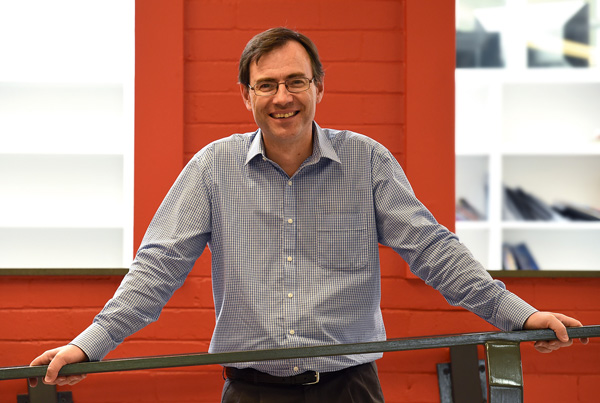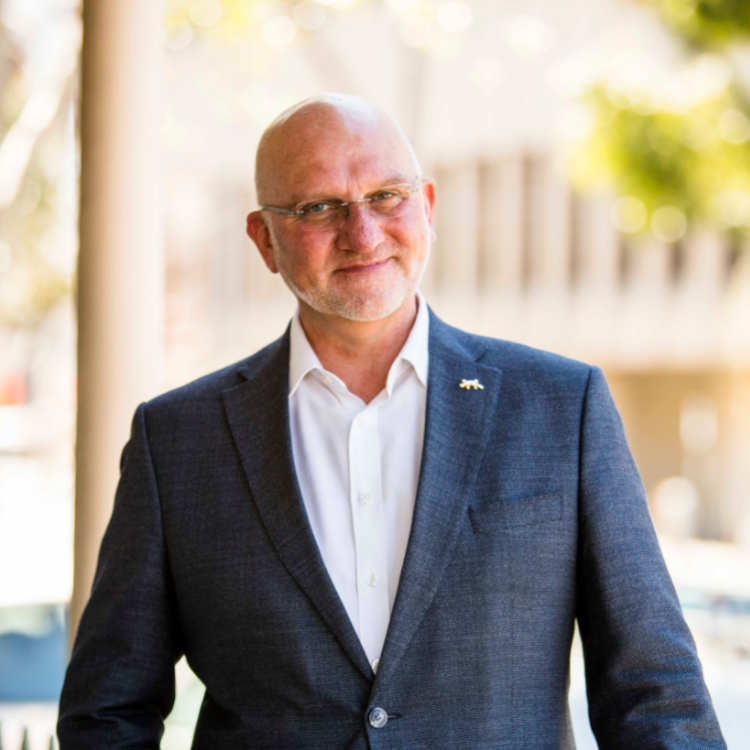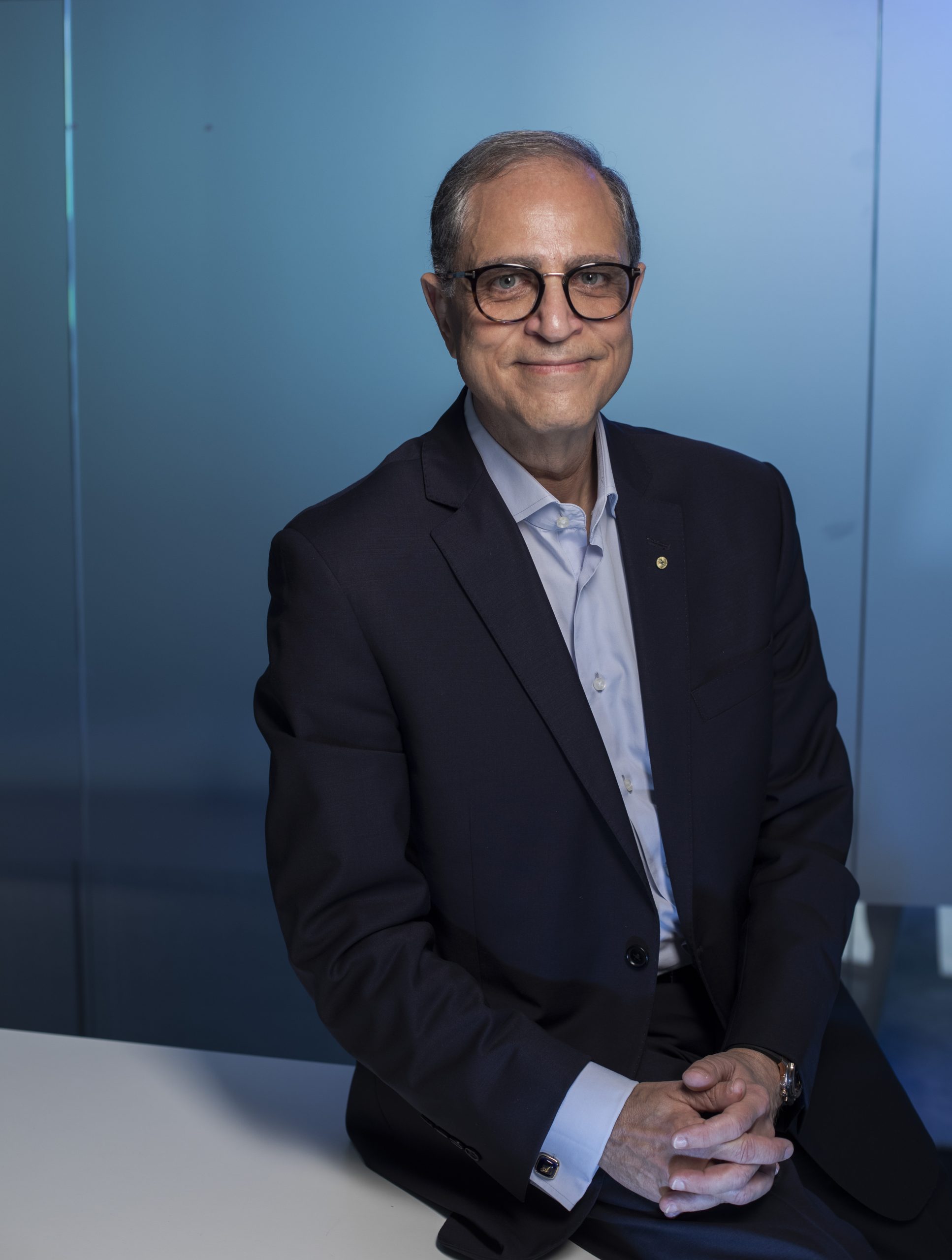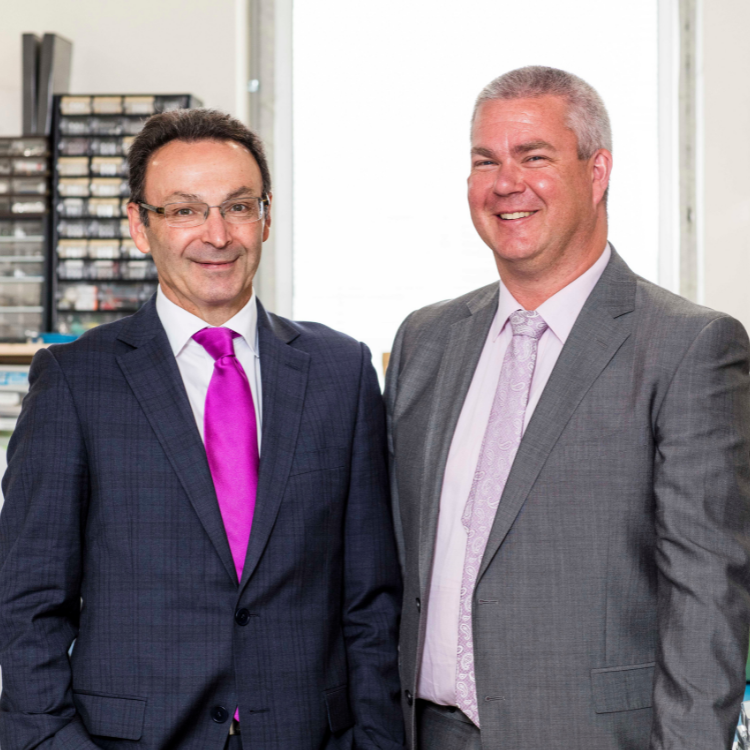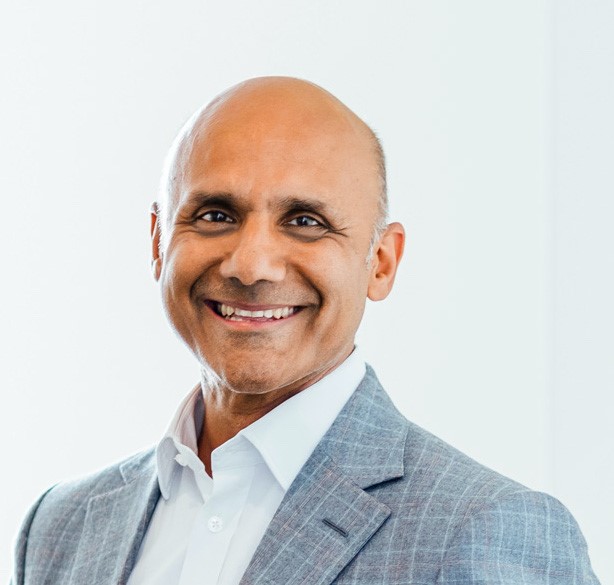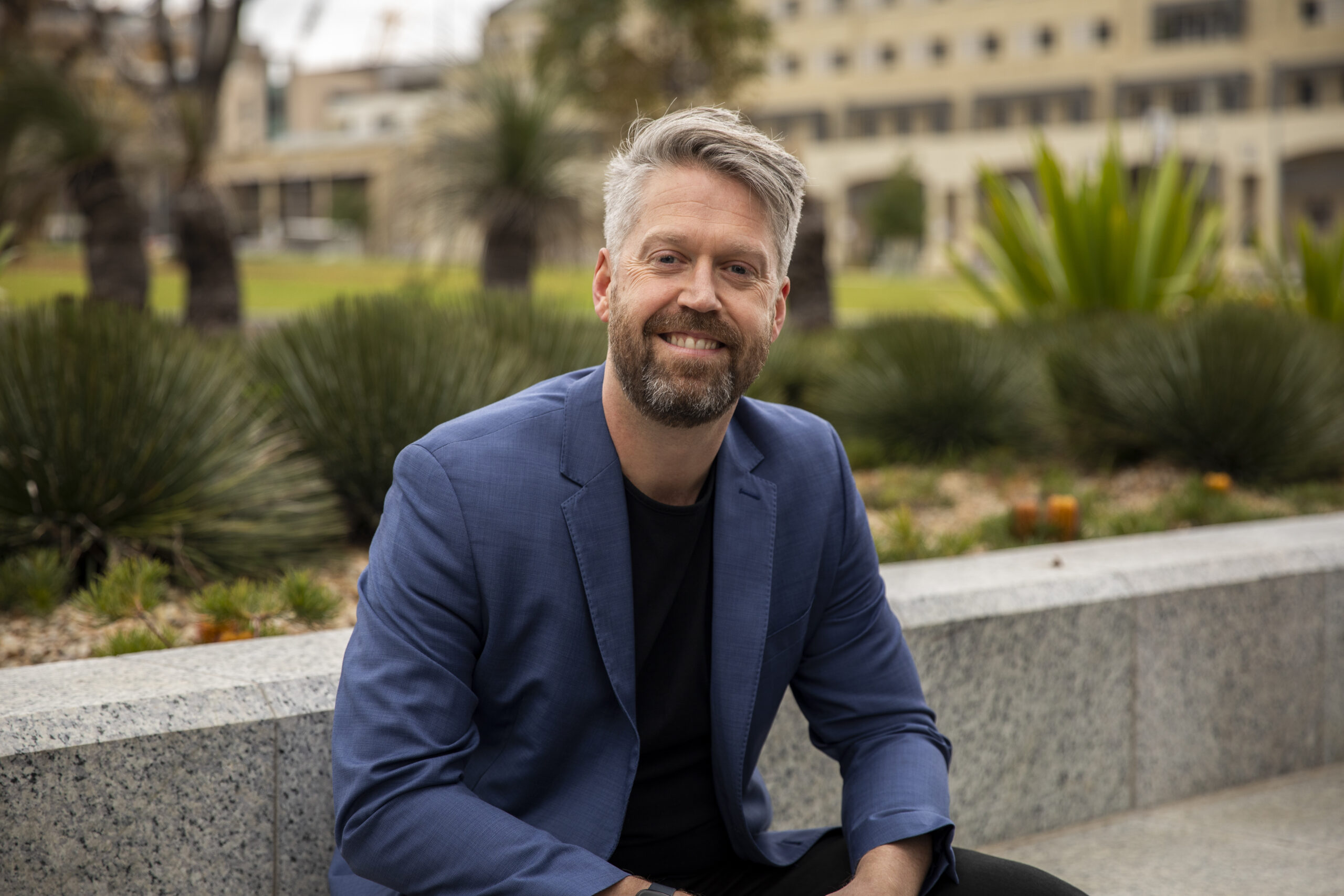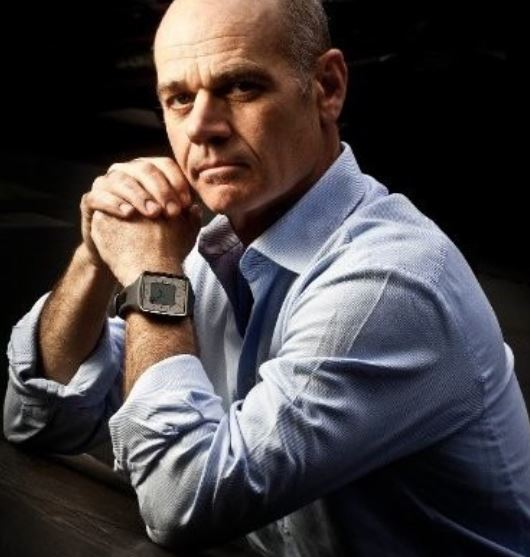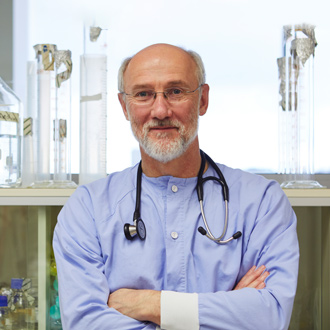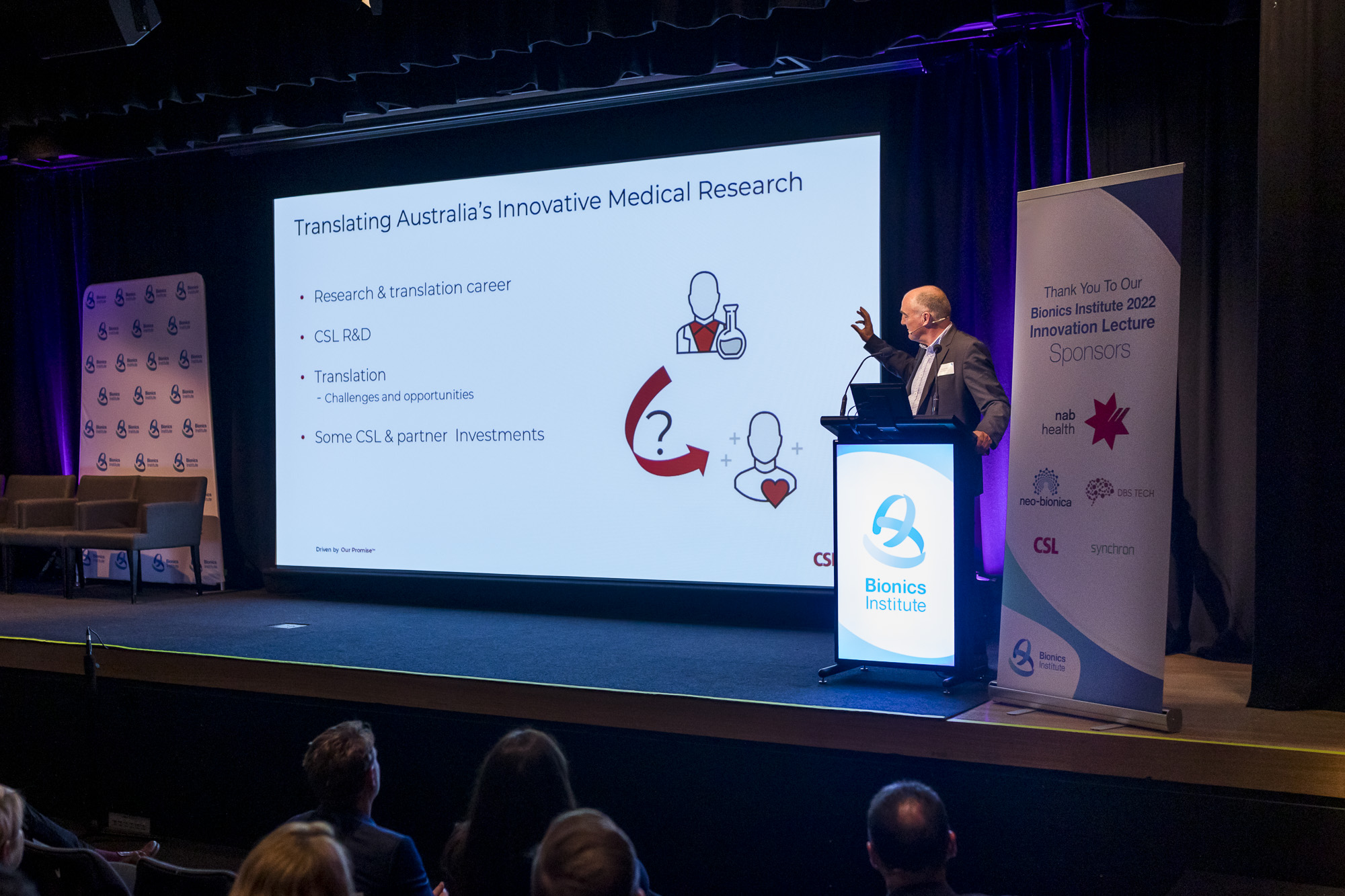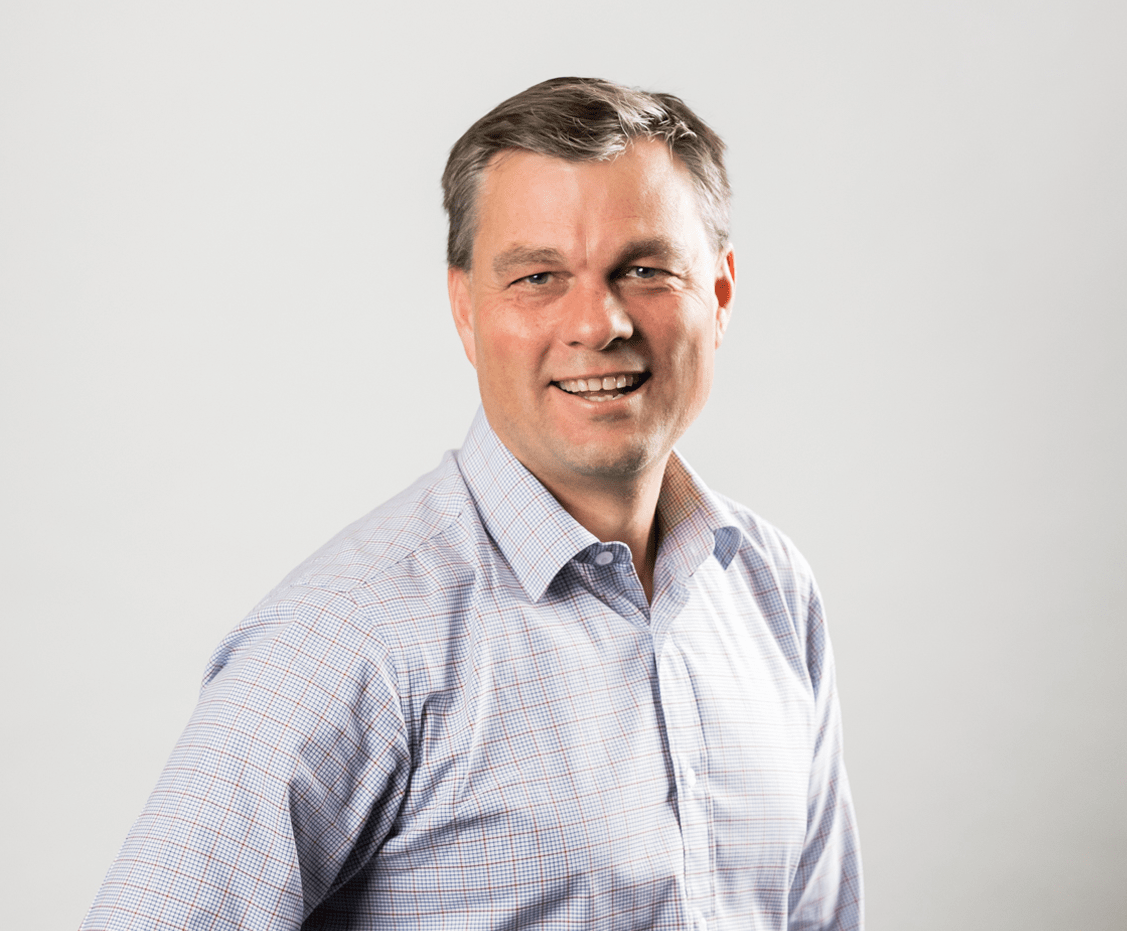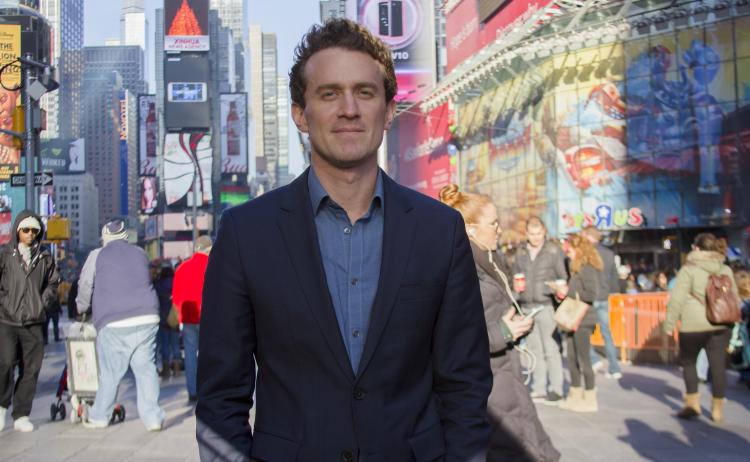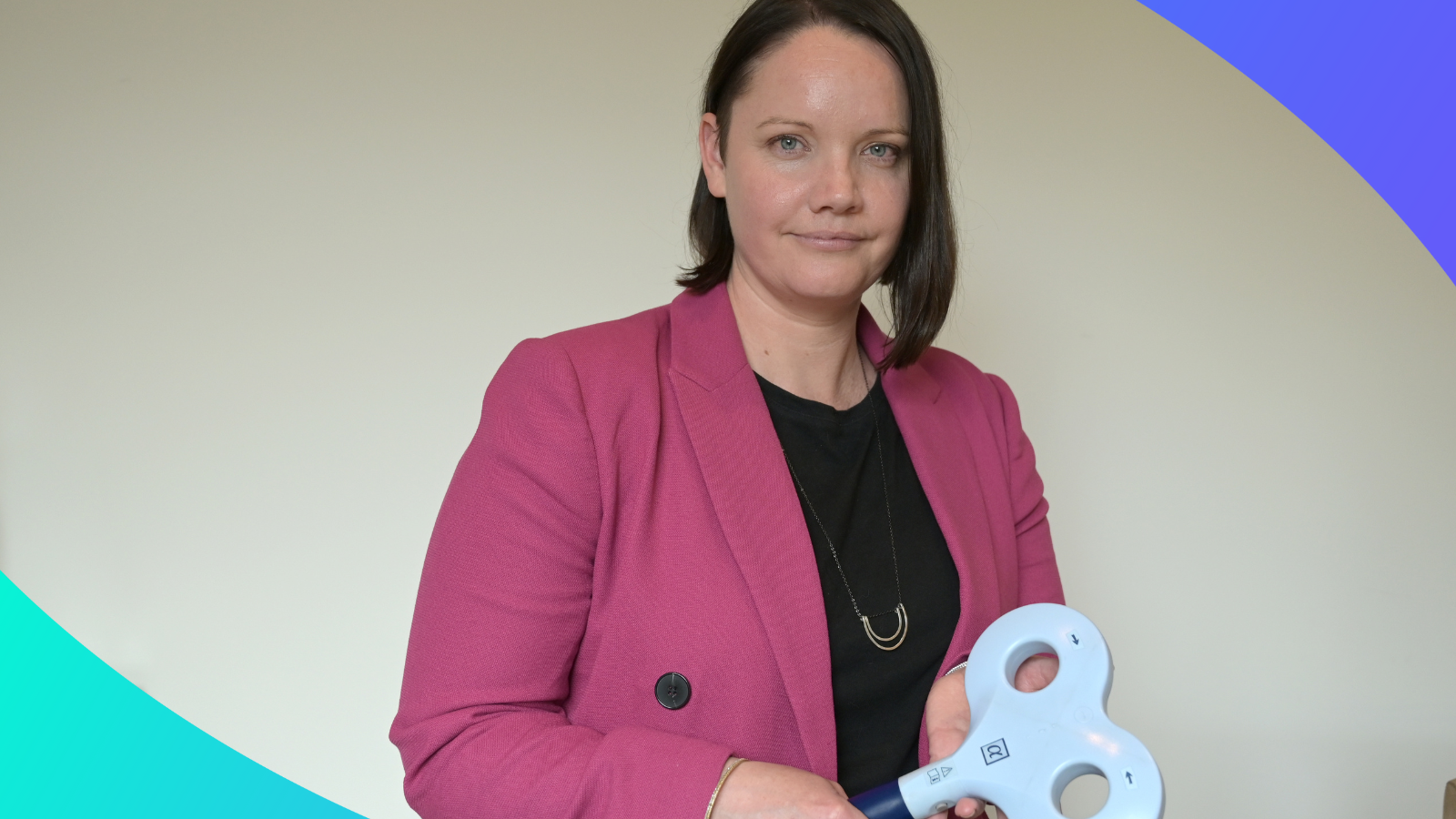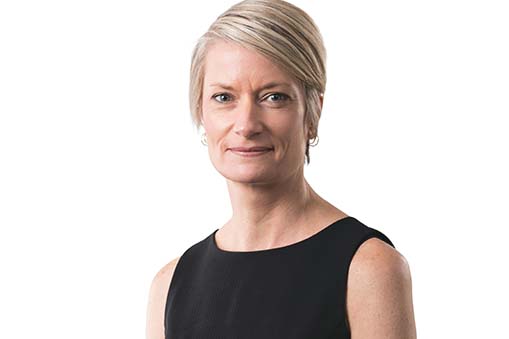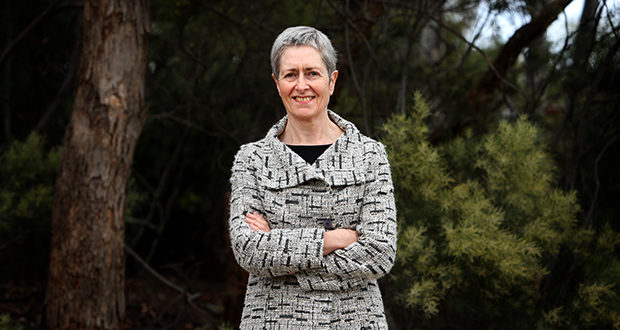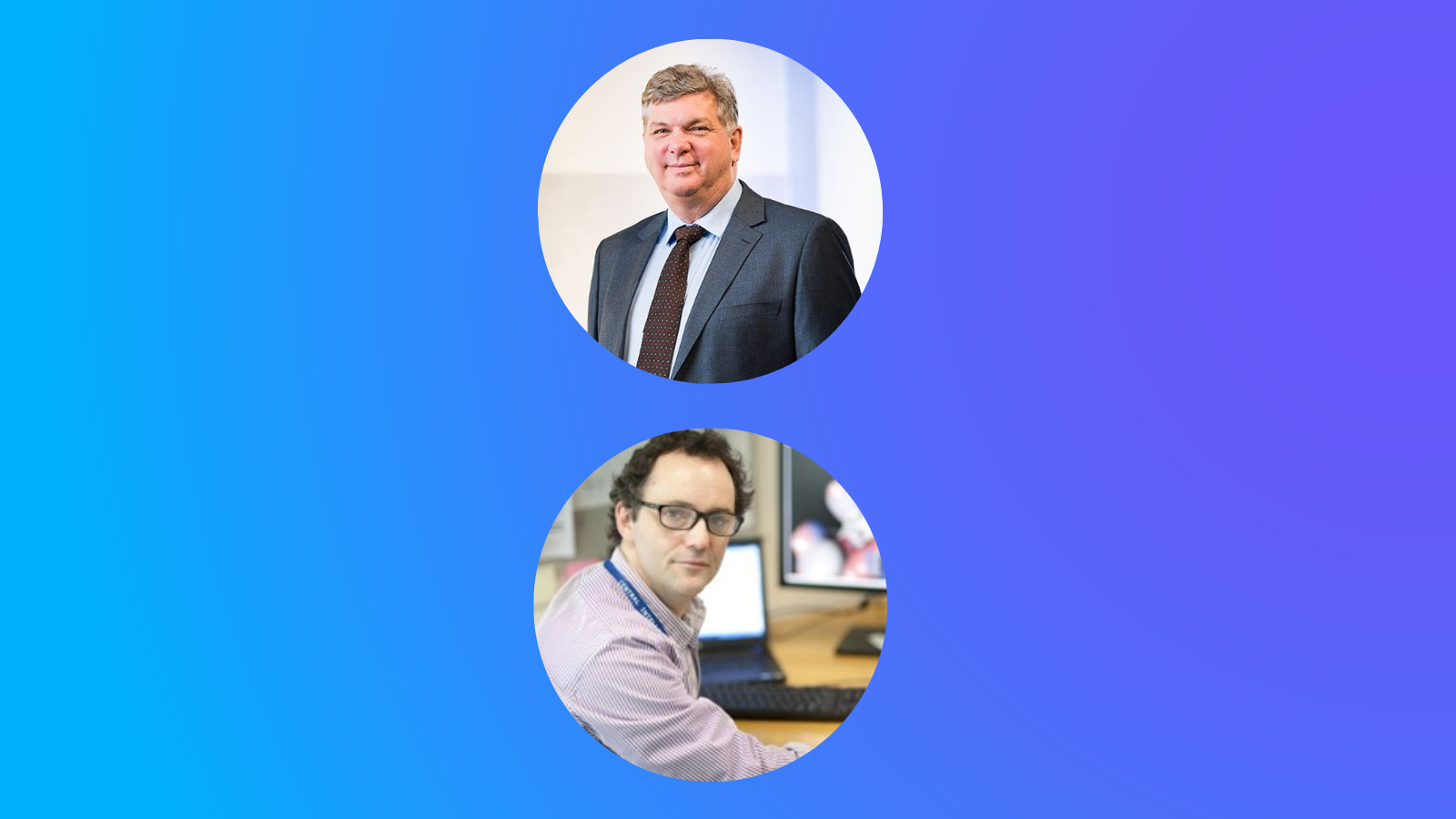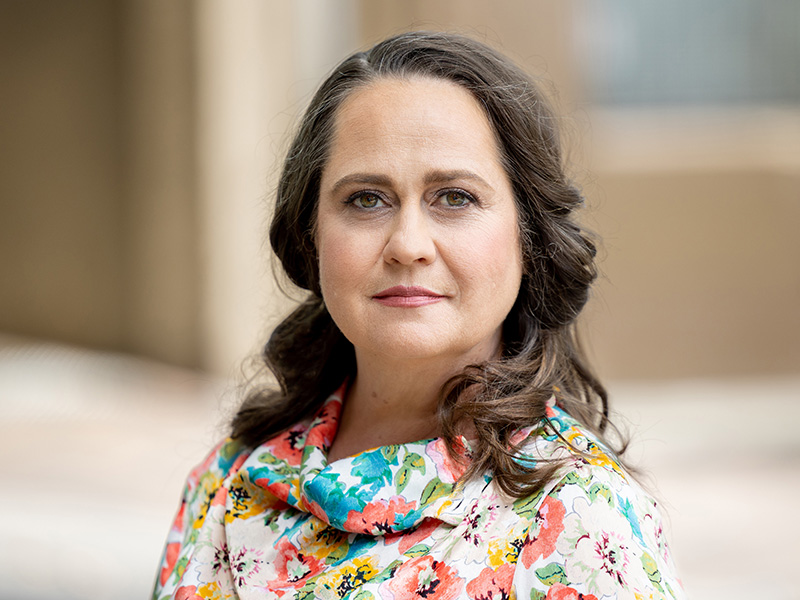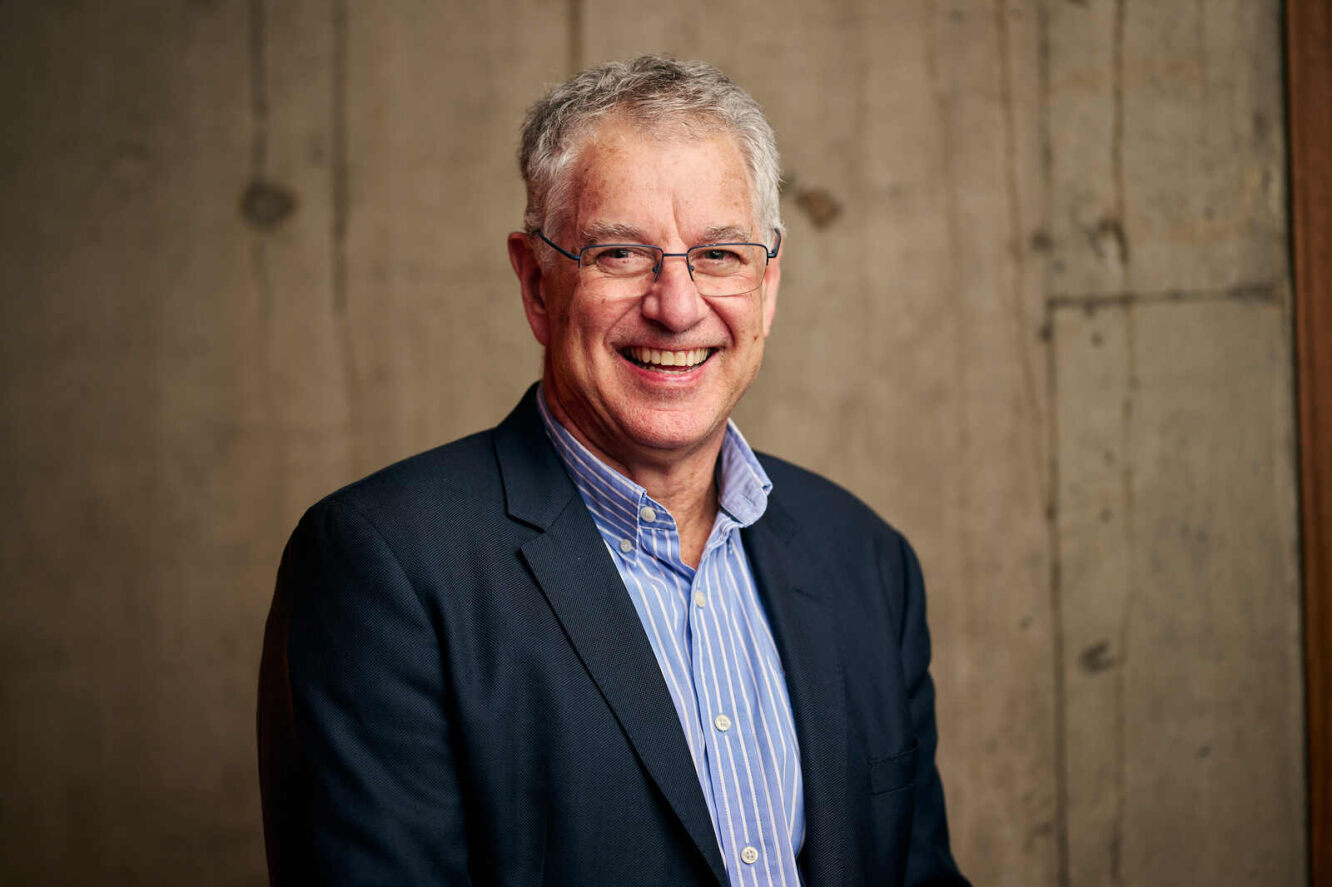Med Tech Talks
Kylie Walker, CEO of ATSE – Bionics Institute 2023 Innovation Lecture special
As CEO of ATSE, Kylie specialises in connecting technologists, engineers and scientists with governments, business, media and society with skills built over many years in senior federal communication and advocacy roles in science, technology and health sectors.
In her keynote, Kylie talks about using metrics to unlock the potential of Australian research and development, and the impact measuring innovation could have for the med tech sector.
Over 320 guests comprising med tech executives, researchers, clinicians, government staff and investors attended the Innovation Lecture to explore how Australia can accurately measure innovation, boost the med tech ecosystem and strengthen connections.
More information:
Watch the Bionics Institute 2023 Innovation Lecture recording
Kylie Walker [00:00:38] Thanks so much, Robert. Thank you for having me here tonight. Friends, it’s an honour to be asked to speak with you here on Naarm Country and the island nation. Australia is home to a rich and ancient history of innovation, which stretches back 60,000 years or more. We are privileged to live among people whose culture represents the oldest continuous knowledge system in the world. Aboriginal and Torres Strait Islander people were and are Australia’s first engineers, scientists, astronomers, ecologists and agriculturalists. Their work and their knowledge remains of vital importance as we look back to move forward through some of the biggest challenges not just for our nation, but for our species and our planet. I pay respect to their elders past and present. And I acknowledge any Aboriginal and Torres Strait Islander people who are here with us tonight. So innovation has always been the foundation for human development. It fuels our health, our social and economic well-being, and it is imperative for improving our responsible stewardship of this beautiful planet’s finite resources. Without innovation, we would stagnate. It is a fundamental source of economic and social progress, and it’s an essential foundation for maintaining a, well, wealthy, resilient and connected nation. Scientists and technologists, I believe, are the imagineers, the adventurers, the people who dare to ask the most difficult questions and conjure the most incredible solutions. Australia is a breathtakingly creative nation. We produce an astonishing amount of new knowledge. Breakthroughs by Australian researchers and developers have revolutionised humanity’s understanding and application of a huge array of science and technology. They or you actually many of the people here in this room tonight have taken us from the discovery of new microbes to antibiotics and through to combating antimicrobial resistance. They’ve unlocked the secrets of major disease and created whole new classes of targeted and highly effective therapeutics. They’ve sounded the warning bells and are crafting the response to climate change. They’ve pinpointed the origins of the universe and helped us understand how the universe continues to change today. All the while, wirelessly connecting the world. As we dive into the long, hard work of energy transition, emerging health crises and challenging regional geopolitics. It is more important now than ever for Australia to invest in creating and applying new knowledge. Our entire population is smaller than Tokyo or Jakarta. But our research is innovators are very high achievers, both for the quality and for the impact of their work. But Australia is still held back from our full R&D potential. We’re held back by a lack of consistent strategic and concerted investment in translation, application and commercialisation of Australian research. Schemes like the Medical Research Future Fund work very well to support commercialising Australian research. But nationally, investment in knowledge creation and application is slipping. We saw that in the Federal Budget as well. Without considered and consistent investment in the research goldmine that fuels the innovation foundry, we risk losing this precious resource. So Australia’s total R&D funding is just 1.8% of our GDP. So it sounds like a lot when you consider it in isolation. But the OECD average expenditure on R&D is 2.67% of GDP. And the world leaders like the United States, Japan and Germany. They’re investing three or more per cent of GDP in research and development. After years of short term thinking, often driven by a short term political cycle. Our Australian R&D sector has been slipping into crisis mode long before COVID 19 came along. The pandemic has then further squeezed research revenue, dried up development pathways and cracked wide open the workforce and skills fissure. So what this means for us is that we’re losing people. We’re losing some brilliant people. As our nation continues to take an inconsistent approach to supporting, resourcing, nurturing and connecting research and development. So these clever and these committed people are not entering our R&D system or they’re leaving it or they’re leaving Australia and they’re leaving us behind. A bouquet of government reviews are underway. The universities accord the review of national science priorities, the Australian Research Council review, and these are all very important efforts to examine how we staff and fund and conduct and innovate and roll out R&D. We have a golden opportunity to redesign Australian R&D, create a sector that supports our future. If the findings of these reviews are heard and the recommendations are acted on. It’s also not too late, I think, to seize the pandemic prompted disruption to the sector as an opportunity to grow Australia’s economy in new directions while creating new opportunities and addressing our more pressing social and environmental challenges. It’s no easy task, but true reform never is. We do have a series of reviews, yes, but we don’t have a big, bold hole of system examination. We still need to do this. We need an independent, forward looking review of Australian R&D as a whole, and we need to be very brave about how we apply its recommendations. I think we should redesign a system that will mature our research and innovation capabilities, help us to reach our full potential over the next 30 years. So imagine what we could achieve together if we had a cohesive and a strategic approach to supporting, enabling and encouraging collaboration across industry, research, government and not for profits. We need a science, technology and engineering ecosystem that’s built on a research landscape that supports a curiosity driven approach to creating and applying knowledge, a system that encourages and nurtures a genuine diversity of talent through all stages of R&D and their career, and a system that understands that this will include some bumps, some detours and some byways and does not punish those who try and fail and want to get up and try again. A system that recognises that the greatest leaps emerge from bringing different types of people from different disciplines, different backgrounds together to craft creative solutions to persistent problems. So as we consider how to tackle those global challenges that we all face today, I think it’s an opportunity to lay the foundations for an extraordinary legacy that will continue to build Australian health, wealth and wellbeing, sustainability for decades to come. Australia has one of the world’s least differentiated economies. We rank 91st on that particular scale in the world, and that’s largely due to the dominance in our economy of agricultural goods and minerals. The Australian Academy of Technological Sciences and Engineering at Sea comprises a little over 900 of the nation’s top thinkers in engineering, technology and applied scientists, and I’m very grateful to see some of the fellows in the audience tonight. We know that this situation is unsustainable. Australia should decide the skills and capabilities that we need to build on and to invest then in the research strength that we need to sustain them. So science, engineering, inventiveness, mathematics, entrepreneurialism and imagination. Our commitment to these is measured by our national investment in R&D. It clearly needs to get better. The federal government has a crucial role in catalysing a cultural and mindset shift. It can, and it must lead by example, not just to say that it values these things, but actually to invest, to demonstrate that it does value these things. The Government must address Australia’s decline in R&D expenditure. It’s now down to its lowest level in terms of government expenditure in ten years. It must address this if we are to regain our position as a global science and technology player and ensure that our economic prosperity. Is assured into the future. Australian innovations are marvellous. There’s plenty of good material to work with here. The astonishing brilliance of our researchers and inventors is what keeps me glued to the work that I do. I have been known to describe myself as Australia’s biggest fan of science and technology. It’s kind of my professional job description. Australian researchers and developers have revolutionised global telecommunications, health and medical care and deepened our understanding and our ability to explore space. We’ve brought food production to dry, salty lands around the world, just to name a few. But we all know tonight that innovation does not stand still. And if we don’t keep investing, and if we don’t revitalise how research is conducted and valued and translated and applied, if we don’t innovate the innovation system, we risk slipping even further behind our OECD peers. The breadth of innovative activities makes this process very hard to define, let alone to measure. But we must keep trying. In 2019, the Academy was commissioned to deliver an independent review on the adequacy of innovation metrics which the government measures and reports on. These metrics are important. They help us measure innovation performance and by tracking innovation metrics. Governments and organisations can look at genuinely look at the effectiveness of innovation work as well as policy that supports it and the funding that is directed towards them and can illuminate areas for improvement. Metrics help us make decisions based on evidence. They provide objective data that can be used to inform the way that research, business and political leadership signals what it values to set regulation and allocate resources, helping to focus efforts on the things that matter. And dumb right metrics also serve to improve innovation culture. We often think about metrics and reporting as kind of an unnecessary and necessary evil. But these are a really powerful tool. And if we embrace them and if we listen to them and we respond to them, metrics can actually help us create a culture of innovation by promoting a focus on continuous improvement, experimentation and entrepreneurialism. And by highlighting the areas where we need intervention and improvement. Metrics are obviously also a very useful tool to persuade partners and investors to get on board. Strong innovation metrics support research institutes to attract funding and partnerships to support growth and development. Of course, individual organisations can also use metrics, innovation metrics to better understand how they compare with their competitors and to identify where they’re lagging and establish the balance between the need to invest in technology and the need to invest in people they can identify and build on their strengths, change their supply chains and improve their value proposition for their customers. For governments with a policy of fostering innovation in the economy, relevant metrics are essential. If they are, if any support they plan to provide is properly targeted and effective. Metrics Assist in determining publicly funded research priorities and identifying education and training needs to support future growth in areas of need, and they help in designing assistance programs. I also like to think that governments genuinely do engage with metrics and use them as a tool to increase their familiarity with our system and what we’re capable of achieving. They can use this information to help promote the need for and the value of innovation, and to help dispel community concerns to encourage laggards to lift their game. So with all of that in mind, as part of the 2022 Innovation Metrics Review, Etsy helped develop a conceptual framework. So at its centre, the framework focuses on the impact of innovation. The review recognised that the breadth of benefits that innovation delivers to society. But it focussed mainly on the economic impacts of innovation, in particular productivity, investment and jobs and exports. These are the areas where innovation policy can have the greatest impact on living standards. So at the middle, the framework identifies those key components of a healthy innovation system creation, diffusion and transfer and application. So these components behave in a non-linear fashion. Creation in this context refers to the creation of new ideas and knowledge. For instance, both R&D and non R&D based knowledge and idea creation are performed by people operating in a whole range of organisations, government businesses, higher education institutions and not for profit organisations. Diffusion and transfer is the exchange adaptation, diffusion and translation of ideas and the distribution of knowledge. This happens when we build skills and capabilities that people can carry with them to other sectors and roles and through the spill-over impacts. When something happens in one sector that affects another as well as through more formal arrangements to collaborate and share information. Application, of course, refers to what we do when we develop and refine and implement innovation. The success of applying innovation depends on many factors, including what skills are available, where the opportunities lie, how easy they are to access, how effectively the regulation and policy settings are operating, whether there are enough people with the right skills and the will available to support the application. The way in which innovation is managed and the level of access to skills and finances are just a few factors there. For all of the components of the innovation ecosystem to operate effectively, a well-functioning, overarching operating environment needs to be in place, and that is the outer circle of the framework. Of course, the operating environment is very big picture, but broadly it covers key areas like culture. Public messaging about innovation and its value domestic governance, workforce pressures, the institutional environment, the availability and the maturity of infrastructure, the readiness of the business and the investment environment and international factors which are almost always out of our control. The framework was used by the review to assess the health of components of Australia’s innovation system, and particularly focusing on those for which there are either very few or no innovation metrics that are currently fit for use. And that was done by mapping the available metrics against the components of the framework. So what did we find? Well, many existing innovation metrics focus on measuring R and D activities and makes sense, right? We’re talking about innovation. That’s research and development. That’s the activity we’ve got to look at. And historically, this is where a large portion of government and innovation policy efforts have been concentrated both here and internationally. But and this is a big part, a lot of innovation activity and expenditure does not actually involve R&D. So those activities are not being adequately measured and the policy levers therefore, that are potentially available to encourage them are not being fully explored. The 2022 report on improving innovation indicators found major gaps in the way that we capture and analyse innovation information. It has 16 recommendations and they are pointed at setting up a whole of government entity to lead and accurately report on how we genuinely perform in innovation as a nation based on more sophisticated data than we’ve been using to date. This entity would also deliver an annual innovation scorecard to track progress against other countries and designed to be used to influence and incentivise productivity in Australia. A precondition for developing successful policy that supports innovation is to measure it well. I’m going to keep coming back to this message and then report on it regularly and transparently and be prepared to respond to what you find. Bringing others in as part of a national conversation. It is a truism of management and planning that you value what you measure. And it’s absolutely true for innovation as well. Etsy has identified four key areas where how we measure and report on Australia’s innovation environment needs to get better and fast. If Australia is to make the most of the extraordinary brain brainpower that we’re lucky enough to call our own. Firstly. The entrepreneurship environment. This is highly relevant innovation associated with new business developments. Secondly, I sat and digital infrastructure, and this plays a crucial role in many aspects of innovation. Measuring digital activity is increasingly important, but where and how the economy has been most impacted by digitalisation is not well measured. Thirdly, research infrastructure. This addresses and supports Australia’s capacity and capability to undertake technology reliant innovation and forth in Australia. There is also a notable gap in the way that we collect data on our science research and innovation performance. Our R&D statistics are only collected every two years, and this leads to a delay of up to four years in the feedback loop for policy making. And if you lay this over a three year political cycle, the ingredients are there for a lot of running hard but getting nowhere. On top of this, many statistics collected by the OECD are not available for Australia. This leads us all to rely on potentially misleading international comparisons, and ultimately it means that our policies are not adequately informed by evidence or by a deep understanding of what is and isn’t effective for our particular ecosystem To develop effective policies that support innovation, collection and regular reporting of innovation. Metrics is crucial. It will give all the players, governments, investors, researchers, industry and other end users a richer, higher quality understanding of how Australia is performing in innovation. And it will empower us to make the best decisions for supporting a thriving future. You may be wondering, given that we did just have a federal budget, how the $15 billion National Reconstruction Fund fits in with all of this. The NRF is aimed at diversifying Australia’s industry and economy. It’s been described by the Science Minister as one of the largest peacetime investments in Australian manufacturing capability. And it’s meant to be an independent financier modelled on the Clean Energy Finance Corporation to provide investment capital, to capture new high value opportunities to diversify and transform Australian manufacturing. Sounds good. The Government hopes it will provide a financial base to attract additional private sector investment across renewables and low emissions technologies in particular, but also medical, manufacturing, transport, agriculture, forestry, fisheries, resources and defence. In 2021 22, there was about $46 billion of capital expenditure across these industry sectors. In our $15 billion, provides about 1.5, which is to provide about $1.5 billion per year over the next decade. So that’s equivalent to about 3% of current private investment. It’s clearly not going to crowd out private investment, but it’s designed to properly attract and bring in new private investment. In order to do this, it will have to be highly strategic. It’ll have to be mindful of and responsive to the actual state of play in the R&D sector and the manufacturing ecosystem as a whole. And it will have to take a sovereign capability approach to industrial transformation. It will have to look at and act on metrics to build an effective innovation strategy that supports Australian R&D to thrive and build domestic economic capacity. We should obviously start with what we know about ourselves. We could and we should use more comprehensive metrics and scorecards to capture innovation activity, align our definitions of innovative businesses with those used internationally. Innovation systems are complex. Scorecards can cut through the complexity and quickly communicate to a broad audience. People you need to know who are making decisions. The most important aspects of innovation that can underpin public discussion about where policymakers might usefully intervene. Addressing information gaps and emerging data needs will require statistical analytical and research solutions to be investigated, developed and applied. Many of the information gaps and emerging data needs highlighted by the review are not unique to Australia. There are plenty of nations around the world that are also grappling with gaps in their innovation, data and analysis. And since many national statistical offices are experiencing the same challenge, then I think there’s an opportunity here to pool brainpower across like minded nations and develop solutions that can be tweaked to meet the specific needs of the individual partners in that nation collective. At the same time, we also need to keep working at recognising and supporting exceptional innovators. I spoke about culture and about signalling and that role modelling is very important and I am going to indulge myself for just a moment and take a moment to highlight the work that we’re doing through our awards at Adatsi. These awards are a suite of national awards that are designed to celebrate and raise awareness of exceptional Australian innovation, both at mid-career and at the senior career level. A couple of early careers as well. They’re open at the moment, so if you think you might be potentially up for one of those, please do qualify. Because what awards and others like this do? It enables us not just to, you know, give somebody a lovely medal and invite them to a nice dinner to celebrate their work. It enables us to tell their stories publicly. It enables us and enables me and my colleagues to take those stories into ministerial offices, into senior departmental offices, into business boardrooms, and talk about the exceptional work that we do here in Australia with a great degree of specificity and excite people in the potential for where that work might lead next. Innovation is essential for human development, for improving economic and social well-being. For the sustainable use of finite resources. Governments worldwide are all wrestling with the question of how to foster more innovation to address major challenges. A strong innovation ecosystem needs leadership that invests in big ideas. Sets clear expectations about direction and financial backers with a healthy appetite for risk based on understanding of how science and technology operate. We need all of these things working together to create an environment that inspires the next generation of researchers, scientists and innovators, and that creates opportunities for them to pursue challenging and exciting and fruitful careers in STEM. To build the best possible foundations for our brightest minds. To let their imaginations fly to pioneer, exciting and sustaining new applied science and technology. Thank you.
Robert Klupacs [00:26:41] Well, thanks very much. That was I think you’ll all agree, a fantastic presentation. And we’ve got time for a few questions and we’ve got one particular that’s come through on Slido from Professor Sally MacArthur on metrics, How do we change what the peer community reviews? An index? An impact factor of journals are used as shorthand for innovation or impact.
Kylie Walker [00:27:09] Well, we value what we measure, as I said. So what we need to do is to take a collective decision to think about different things, to value. If you think those metrics are not the only metrics we should be looking at, yes, they are appropriate metrics and they’re important metrics. Let’s have a look at how well is an individual collaborating? How well is an individual applying the work that they’re doing? What kind of impact, if they had in the community, are they fostering the next generation? Are they providing opportunities for different ways to tackle problems? And if we start to look at their public awareness, for example, are they speaking where possible and where appropriate about the work that they’re doing? There are, you know, the well, the sky’s the limit, really. You can choose your own metrics. All we have to do is actually agree that that’s what we’re going to think about and look at and value testing.
Robert Klupacs [00:28:06] We have a second question here from Clint Rogers. What do you believe are the advantages and disadvantages of competition between states attracting and sustaining a medtech sector?
Kylie Walker [00:28:19] Well, competition can be terrific for generating ideas and innovation, particularly if that competition is based on meaningful and longer term sustained investment, and that there are clear pathways to success available where competition may not be so useful in a reasonably small nation is where we start to cannibalise ourselves and we start to fight for those scanty resources. That ends up being a little bit self-defeating, I think, because we’re already as I’ve already quite clearly mentioned, we’re already looking pretty low in terms of overall national investment in R&D. So if the competition lifts the investment, terrific. If it means that we’re fighting over scraps, not sour grapes.
Robert Klupacs [00:29:06] Right. The question we have from Emma Burrows, do you have ideas for how to link metrics to positive culture?
Kylie Walker [00:29:17] I do, but I might give you an example that’s not actually in R&D specifically and something that I’ve been applying at my workplace, and it’s around building culture and connection. There are ways to measure this. Outputs are usually not it. You have to look at things like wellbeing. You have to look at things like commitment to coming to work, how connected to people feel to the mission of the organisation. You have to look at things like are people collaborating effectively across teams? And then you start to wonder about whether we’ve got the tools to support those things to happen, or if you’re asking them to do it against the odds. And I’m I want to give you one example of a conversation I had a little bit earlier today with another panelist, actually, today’s Idaho but Day, International Day Against Homophobia, Biphobia, Intersex Phobia and transphobia. And these occasions are really important opportunities for employers to demonstrate very clearly and proactively that they are good allies and they are creating safe spaces. If you leave that up to the people who might fall into those categories, what you’re saying is, Hey, minority group, it’s your job to fix the problem and make us feel more comfortable. But if you put a structure and a system in place that puts the onus on managers, on senior leaders, on the allies to demonstrate very clearly and effectively and genuinely that it’s a safe and a welcoming space. And then you ask those managers and those senior leaders to report back on how they’ve done that, you can effect culture. You start to demonstrate very clearly, not just that you’re going to say that it matters, but that you’re going to ask people to be accountable for making sure that it is demonstrated to people that it matters.
Robert Klupacs [00:31:14] Just one last question for you, and there’s more that dealt be the last. You make some great points. This is from an anonymous. You made some great points about the ATSE Awards. What more can we do to recognise the giants of our industries and innovators?
Kylie Walker [00:31:30] We are getting better in Australia at celebrating people who are clever. You know, growing up, I’m sure I’m not alone in knowing that the heroes, the main heroes that we support, is supported with sporting heroes. We’re actually getting a lot better at celebrating clever people. And, you know, I and many other people in this room have been really instrumental in changing that culture by creating programs and structures to be able to support scientists, technologists, engineers, to learn how to be great and confident communicators and then provide opportunities for them to speak on a public stage. And actually, I think role modelling and that kind of storytelling in public fora is crucially important because this is a it’s an industry, it’s a sector of problem solvers, it’s a sector of creators, it’s a sector of innovators, and as I said, Imagineers and pioneers. But if the only role models that people have to look to in science, technology, engineering and maths, that old kind of old fashioned trope of the older man in the lab coat beavering away on his own in the bottom of a basement somewhere, then it’s not going to inspire young people to want to join the sector, is it? So I’m delighted that that has changed over the last ten years. Get involved in supporting those programming, those programs that are involved in building role models, superstars of STEM, the Elevate boosting women in STEM program. There are a whole raft of them across various states and territories and different organisations put forward good people. Four awards and make sure you look a little deeper to find the people that you want to put forward for awards. Don’t just kind of do it for your mate who’s sitting in the office next door or the lab down the corridor. And think about being a sponsor, not just a mentor to the young people in your world as well. So sponsoring obviously involves doing something to connect and open doors for that person, not just giving them some advice about how they might do it for themselves.

Kylie Walker, CEO of Australian Academy of Technology and Engineering.
Listen to other episodes of Med Tech Talks here


